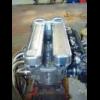Rally Brakes Bit Weak: Perhaps Install A Servo Or Try New Pads?
#1

Posted 01 April 2011 - 05:15 PM
Someone suggested putting a Servo in the car.
* Is this practical -or desirable?
* Are there any other/better solutions?
ROADRUNNER has advised that:
I used Metro Turbo vented discs and 4 pot callipers on the road car I just sold but did not use a servo, did not think it needed it. Before that they were STD 8.4 discs and I was very unimpressed with the breaking. I did have a Mini with a servo and found that quite adequate and really braked well.
Years ago I worked as a mechanic on a Mini Se7en which used S brakes and no servo. th edriver was very hard on the brakes but came second in the championship.
I think a servo is a must on a rally car especally on 8.4" discs. The rear drums should be Super Minifins which the Minisport ones are a copy of.
What brake pads are you useing, Frodo, Mintex, or Green stuff. If I were you I'd ask a few of your compeditor minis what type of brakeing they use or have a look under the bonnet.
Front:
AP 2 pot calipers
8.4” cross-drilled & grooved discs
Rear:
Mini Sport Super Fin alloy drums (for extra cooling)
http://www.minisport..._MSLMS0507.html
£88.77 inc VAT
These alloy brake drums are the same dimensionally as the stock "S" rear drum which means they have the built in 1" spacer. Plus the alloy material is also has a finned design that dissipates heat quicker which in turn helps reduce brake fade. While designed as a direct replacement for the "S" rear drums
Wilwood brake bias valve
Full spec on the car's blog:
http://www.theminifo...x...=129848&hl=
#2

Posted 01 April 2011 - 05:32 PM
#3

Posted 01 April 2011 - 08:50 PM
Servo not needed for such a small car - and doesn't improve the brakes anyway - it just reduces leg load, and adds weight! Try different pads. You don't say what pads you have at present? Also - don't brake so much! Carry the speed through the corners!!
i agree with this dont fit a servo i run S brakes on mine and i can quite happily lock the wheels at 30mph on dry tarmac, and on wet tarmac i can lock all 4 wheels if wanted.
and i like that don't brake just corner faster
#4

Posted 01 April 2011 - 08:55 PM
#5

Posted 01 April 2011 - 09:48 PM
#6

Posted 01 April 2011 - 10:33 PM
#7

Posted 01 April 2011 - 11:25 PM
Go to DOT 4 brake fluid. DOT 5 has too much viscosity for a mini brake system,
No, you can boil DOT4 under real rally conditions (been there, done that). Use AP600 race fluid.
#8

Posted 02 April 2011 - 12:17 AM
#9

Posted 03 April 2011 - 11:13 AM
dot 5.1 is good. dot5 can find it's way past seals quite easily.
Have you had this happen? Why would 5.1 be any better?
In what way is DOT 5 the wrong viscosity for a Mini braking system, given the similarity to any other car's braking system?
#10

Posted 03 April 2011 - 11:42 AM
dot 5.1 is good. dot5 can find it's way past seals quite easily.
Have you had this happen? Why would 5.1 be any better?
In what way is DOT 5 the wrong viscosity for a Mini braking system, given the similarity to any other car's braking system?
Dot 4 and 5.1 are similar. Dot 5 however is silicone based and doesn't mix well with 4 or 5.1
Wiki:
Not to be confused with DOT 5.1, a polyethylene glycol based fluid.
DOT 5 is one of several designations of automotive hydraulic brake fluid, denoting a particular mixture of chemicals imparting specified ranges of boiling point.
DOT 5 is a silicone-based brake fluid (contains at least 70% by weight of a diorgano polysiloxane[1]).
Unlike polyethylene glycol based fluids, it is hydrophobic. Its chief advantage over other forms of brake fluid is that silicone exhibits a more stable viscosity index in extreme temperatures. It is widely used in the antique automobile arena as well as it does not damage paint.
Using DOT 5 in a DOT 3 or DOT 4 system without proper flushing will cause damage to the seals and cause brake failure. DOT 5 brake fluid is not compatible with anti-lock brake systems.
DOT 5 brake fluid absorbs a small amount of air requiring care when bleeding the system of air.
Boiling pointsMinimal boiling points for these specifications are as follows (wet boiling point defined as 3.7% water by volume):
Boiling point ranges [2] Dry boiling point Wet boiling point
DOT 3 205 °C (401 °F) 140 °C (284 °F)
DOT 4 230 °C (446 °F) 155 °C (311 °F)
DOT 5 260 °C (500 °F) 180 °C (356 °F)
DOT 5.1 270 °C (518 °F) 190 °C (374 °F)
#11

Posted 03 April 2011 - 01:59 PM
Having groaned when I read your post and assumed I'd foolishly put silicone fluid into the car (which I would NEVER want to do given its rep for eating seals!), I looked up in my notes and this is what's in it, thankfully:
MOTUL DOT 5.1 BRAKE FLUID
Long life 100% synthetic fluid
for hydraulic actuated-brake and clutch systems
DOT 5.1 NON-SILICONE BASE
TYPE OF USE
All types of hydraulic actuated-brake and clutch systems
in accordance with DOT 5.1, DOT 4 and DOT 3 manufacturers’ recommendations.
Fluidity specially designed for anti-locking brake system (ABS).
PERFORMANCE
STANDARDS : FMVSS 116 DOT 5.1 NON SILICONE BASE & DOT 4 & DOT 3
SAE J 1703
Long life fluid :
The high wet boiling point (185°C / 365°F), superior to DOT 4 (155°C / 311°F mini) and DOT 3 (140°C / 284°F
mini) fluids enables to use this product longer. Indeed, DOT 3 / DOT 4 and DOT 5.1 brake fluids have the property
to absorb humidity contained in the air, which reduces their boiling points and consequently security.
The wet boiling point is representative of the fluid after one year of use.
Specially designed to anti-locking brake systems (ABS) :
The viscosity (820 centipoises at -40°C / -40°F) lower than DOT 4 (up to 1800 cp) and DOT 3 (up to 1500 cp)
brake fluids, allows an easier fluid circulation in micro-valves of anti-locking systems.
Perfectly neutral with seals used in braking systems. Anti-corrosion.
RECOMMENDATIONS
Mixable with DOT 3, DOT 4 and DOT 5.1 NON SILICONE BASE products.
Do not mix with silicone (DOT 5 silicone base) or mineral base fluids (LHM).
Store brake fluid in its original container, tightly closed to prevent absorption of moisture.
Aggressive chemical product if contact with hands, paint or varnish.
If skin contact, rinse thoroughly with water.
Drain interval : 12 to 24 months as per manufacturers’ recommendations.
PROPERTIES
100% synthetic fluid, polyglycol bases.
Yellow colour.
Dry boiling point 270 °C / 518 °F
Wet boiling point 185 °C / 365 °F
Viscosity at -40°C (-40°F) 820 mm2/s
Viscosity at 100°C (212°F) 2.1 mm2/s
#12

Posted 03 April 2011 - 02:50 PM
#13

Posted 03 April 2011 - 03:48 PM
That is the fluid recommended to me by the old Ferodo Tech support Dep't when I boiled DOT 4.
#14

Posted 03 April 2011 - 04:45 PM
Fine, you do it your way. Afterall you are the one complaining about the brakes.
I don't think you've read the previous posts. Dot 5.1 is always better then dot 4. You have to be careful with dot 5. The numbering is weird. Like Cooperman says ap600 is one of the best. I would be looking at the pads and start working out. Don't bother with a servo because it weighs about 1000 lbs.
Edited by Ibexx, 03 April 2011 - 04:46 PM.
#15

Posted 03 April 2011 - 06:24 PM
Fine, you do it your way. Afterall you are the one complaining about the brakes.
I don't think you've read the previous posts. Dot 5.1 is always better then dot 4. You have to be careful with dot 5. The numbering is weird. Like Cooperman says ap600 is one of the best. I would be looking at the pads and start working out. Don't bother with a servo because it weighs about 1000 lbs.
Wow, that's a heavy old servo
I like a servo, but it's a personal thing I guess. I did try my 'S' without a servo and nearly put it off the road going downhill in a little lane in the wet as at first I didn't push hard enough, then I pushed too hard and it went 'all-slideways'. Just a case of getting used to it I guess.
1 user(s) are reading this topic
0 members, 1 guests, 0 anonymous users


















